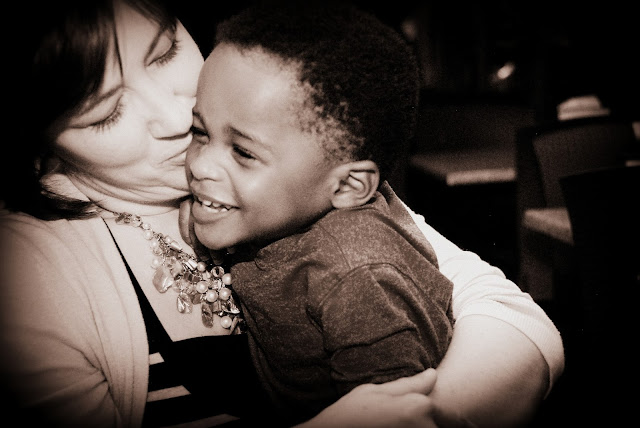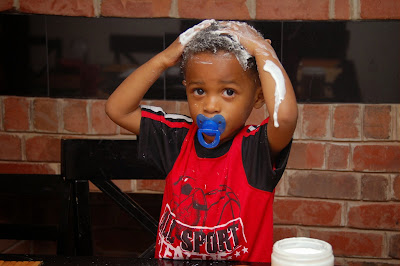If you're like I was before adopting transracially, you honestly may not even know where to begin when it comes to teaching your white children about race.
No one around you is really talking about it or sees the need to.
You're afraid to bring it up for fear of saying something offensive or stupid.
Or what happens if your child takes something you've said and embarrasses you in public by an innocent, but potentially offensive, racial comment?
Whatever your fears or reluctancy, I'd encourage parents to begin teaching their white children about race. (I specify white children in this blog post because I think it's fairly safe to assume parents of minority children are already naturally talking about race, while white culture tends to avoid the topic like the plague in the "virtuous" attempt to be colorblind.)
Pleeeease teach your children what race is, why we're different, and why we should CELEBRATE the fact that God designed humans in a vast array of colors. Don't shy away from teaching them our country's shameful history with race, and how they can grow up breaking the generational sins of racism for our future.
Do it for the benefit of your child's world view.
For the benefit of their future relationships.
For the benefit of our cities and our country and our world.
Here are just a few practical ways to start.

1.
Children's books. The library is an educational gold mine for parents in so many ways. But try looking at children's books through the eyes of my son, and you'll quickly see how overwhelmingly white our world is.
Look for children's books where the main character isn't always white. (I'll warn you, it's unfortunately a challenge.) Look for stories set in the context of other cultures that might provide a good springboard for discussion.
Check out or purchase children's books about important non-white historical figures on your child's reading level. We currently own children's books about Martin Luther King, Jr, Jackie Robinson, and the story of Ruby Bridges, and I'm always excited to get my hands on more. These stories (even written on the level for Jameson!) don't sugar coat our nation's history, and I'm telling you, it was initially really hard to read the words "Black children were not allowed on the playground with white children" aloud to my children. (Ugh. Can't we just skip over that part?) But it's important that our kids know where we've been in order to understand the world in which they live and continue the long-term process of reconciliation in America's dysfunctional race relations.
 |
| I found this artwork the other day when Caroline had traced her and Jameson's hands. I love that she connects how history (particularly the efforts in the civil rights movement with Dr. Martin Luther King, Jr) has enabled our family to exist! |
2. Toys. Buy your younger children dolls and toys of other ethnicities. Our kids take their cues in beauty and value from us. As parents, we have a unique opportunity to help shape our children's worldview by being a little more intentional about what we place in front of them. Brown-skinned dolls are not just for brown-skinned girls. In our house, we love Disney's Doc McStuffins, because it's a rare treat to find a tv show where the beloved main character is African American.
3. Conversations. As a family, we have an open, ongoing dialogue about race just as we do about subjects like adoption, family, God, healthy foods, alopecia, etc. In other words, the topic of race isn't a "once and done" discussion. (obviously, for our family it can't be!) Ask your kids open-ended questions and listen to their thoughts and ideas when it comes to race and differences.
4. Relationships. I can't stress this one enough. The best way to "teach" your white children about race is to encourage them to enter into relationships with children of other races and have them see YOU doing the same. We didn't move to our current neighborhood just so that Jameson could be around kids that look like him. That's certainly a huge benefit. But we realize it's just as important for us and for Caroline to be in a diverse community, too.
Sadly, statistics overwhelmingly show that whites prefer a white world, both in their neighborhood, school choices, facebook newsfeeds, etc. I'd argue this racial isolation is truly a loss for whites, because while exposing oneself to other cultures and ethnicities might at first be uncomfortable, it's unbelievably rewarding and challenging (in a good way!) to one's personal growth.
I can't talk enough about how my own cross-cultural relationships have changed me. We all need friendships where we can ask honest questions without the fear of judgment. When we enter into relationships with people who appear to be different, we have a unique opportunity to see how very alike we all really are (because we're all made in God's image) and learn from His diverse children who carry beautiful perspectives that we white folks need to hear.
So go ahead. See color. Teach your kids to do the same. And marvel together at what an amazing display of color and culture God has made in humanity.



























